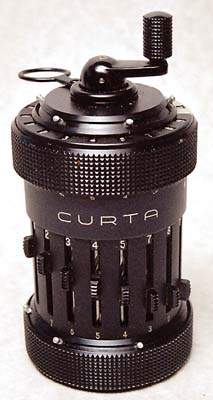Perhaps no calculator of any type has generated more discussion than the Curta. Although a book could be written on this incredible device and its inventor, I will limit this article to a very brief summary. In the future I'll discuss more details and explain how this wonderful machine actually works.
What is it? The Curta looks like a small metal pepper-mill or coffee grinder. It is, in fact, a precision instrument which performs calculations mechanically using no electric or electronic parts. I can best describe the sensation of turning the crank on a Curta as being similar to winding a fine 35mm camera. To the best of my knowledge it is the smallest mechanical calculating machine ever built.

Curta Type I
Who invented it? Mr. Curt Herzstark of Austria.
How was it invented? Over the years I've heard rumors that Mr. Herzstark secretly developed the Curta while imprisoned in a German concentration camp. Apparently this is almost true. Herzstark was a prisoner at Buchenwald but the camp leaders were aware of his work and encouraged it. They apparently wanted to give the invention to the Fuhrer as a victory gift at the end of the war! Herzstark was given a drawing board and worked on the design day and night. The camp was liberated in April, 1945 by the Americans. Herzstark survived as did his revolutionary concept for a miniature calculator. (More details about how Curt Herzstark ended up in a concentration camp in a future issue.)
When were the Curtas made? Although several prototypes were made, the first production began in April, 1947. The last Curta was made in November, 1970 but they were still sold until early 1973. By then, pocket electronic calculators were selling for under $100 and a precision mechanical instrument like the Curta could no longer compete.
Are there different Curta models? The Curta II is slightly larger than the original Curta. It was first produced in 1954 and has a larger numeric capacity than the Curta I.
How many Curtas were produced? In 1949 only about 300 Curtas could be produced each month. By 1952, production had increased to about 1,000 units per month. Over the course of about 20 years approximately 80,000 of the Curta I and 60,000 of the Curta II were constructed.
Are there any Curta prototypes? Mr. Herzstark kept three prototypes in his home in Nendeln, Liechtenstein. Upon his death in 1988 they were sold to a private collector.
Are there different protective cases? Since the Curta is a precision instrument, it was sold with a protective capsule or case. These are screw-top cylinders often with internal padding. Some plastic capsules were made but these were found not to be suitable so production was stopped and the metal cases again prevailed. Apparently Prince Heinrich von Liechtenstein found the metal case to be too rigid for a precision instrument so he had a special leather case crafted for his Curta.
Why does the cap of the Curta's protective capsule screw on backwards? I had always assumed that this was to prevent someone from hastily unscrewing the cap and dropping the fine instrument on the floor. I recently learned that this was actually a design change made to prevent the accidental turning of the Curta's operational crank when the case was screwed shut. This accident would leave the Curta not ready for calculation when the case was opened. Early metal cases having a clockwise closing cap are apparently quite rare.
Special thanks to member Bob Otnes in Palo Alto, CA and Peter Kradolfer in Germany for providing information used in this article.
Copyright 1997, Bruce Flamm
More About Curt Herzstark ("Mr. Curta")
For those who would like to learn more about Curt Herzstark, who designed the Curta, the Charles Babbage Institute offers an oral history transcript with an interview of Mr. Herzstark. For more information, go to:
http://purl.umn.edu/107358.
Thanks to Rick Furr for the info!
Highly recommended is the YouTube video"How the CURTA Works" at https://www.youtube.com/watch?v=loI1Kwed8Pk
For much more information about Curta calculators visit "The Curta Calculator Page" and "Curta.Org: Your Complete Curta Calculator Site".
If you do not own a Curta calculator then you can experience one by using the Curta Simulator 'YACS - Yet Another Curta Simulator' authored by Olaf Veenstra. It takes a little time to start up but it is worthwhile since this incredible simulation also allows you to view the internal workings of the Curta.
Calculator Articles
Vintage Calculators
Text & photographs copyright, except where stated otherwise, © Nigel Tout 2000-2026.


